Qingchao Li
Holographic Metasurface-Based Beamforming for Multi-Altitude LEO Satellite Networks
Jan 07, 2025



Abstract:Low Earth Orbit (LEO) satellite networks are capable of improving the global Internet service coverage. In this context, we propose a hybrid beamforming design for holographic metasurface based terrestrial users in multi-altitude LEO satellite networks. Firstly, the holographic beamformer is optimized by maximizing the downlink channel gain from the serving satellite to the terrestrial user. Then, the digital beamformer is designed by conceiving a minimum mean square error (MMSE) based detection algorithm for mitigating the interference arriving from other satellites. To dispense with excessive overhead of full channel state information (CSI) acquisition of all satellites, we propose a low-complexity MMSE beamforming algorithm that only relies on the distribution of the LEO satellite constellation harnessing stochastic geometry, which can achieve comparable throughput to that of the algorithm based on the full CSI in the case of a dense LEO satellite deployment. Furthermore, it outperforms the maximum ratio combining (MRC) algorithm, thanks to its inter-satellite interference mitigation capacity. The simulation results show that our proposed holographic metasurface based hybrid beamforming architecture is capable of outperforming the state-of-the-art antenna array architecture in terms of its throughput, given the same physical size of the transceivers. Moreover, we demonstrate that the beamforming performance attained can be substantially improved by taking into account the mutual coupling effect, imposed by the dense placement of the holographic metasurface elements.
Space-Air-Ground Integrated Networks: Their Channel Model and Performance Analysis
Dec 21, 2024Abstract:Given their extensive geographic coverage, low Earth orbit (LEO) satellites are envisioned to find their way into next-generation (6G) wireless communications. This paper explores space-air-ground integrated networks (SAGINs) leveraging LEOs to support terrestrial and non-terrestrial users. We first propose a practical satellite-ground channel model that incorporates five key aspects: 1) the small-scale fading characterized by the Shadowed-Rician distribution in terms of the Rician factor K, 2) the path loss effect of bending rays due to atmospheric refraction, 3) the molecular absorption modelled by the Beer-Lambert law, 4) the Doppler effects including the Earth's rotation, and 5) the impact of weather conditions according to the International Telecommunication Union Recommendations (ITU-R). Harnessing the proposed model, we analyze the long-term performance of the SAGIN considered. Explicitly, the closed-form expressions of both the outage probability and of the ergodic rates are derived. Additionally, the upper bounds of bit-error rates and of the Goodput are investigated. The numerical results yield the following insights: 1) The shadowing effect and the ratio between the line-of-sight and scattering components can be conveniently modeled by the factors of K and m in the proposed Shadowed-Rician small-scale fading model. 2) The atmospheric refraction has a modest effect on the path loss. 3) When calculating the transmission distance of waves, Earth's curvature and its geometric relationship with the satellites must be considered, particularly at small elevation angles. 3) High-frequency carriers suffer from substantial path loss, and 4) the Goodput metric is eminently suitable for characterizing the performance of different coding as well as modulation methods and of the estimation error of the Doppler effects.
Ergodic Spectral Efficiency Analysis of Intelligent Omni-Surface Aided Systems Suffering From Imperfect CSI and Hardware Impairments
May 02, 2024



Abstract:In contrast to the conventional reconfigurable intelligent surfaces (RIS), intelligent omni-surfaces (IOS) are capable of full-space coverage of smart radio environments by simultaneously transmitting and reflecting the incident signals. In this paper, we investigate the ergodic spectral efficiency of IOS-aided systems for transmission over random channel links, while considering both realistic imperfect channel state information (CSI) and transceiver hardware impairments (HWIs). Firstly, we formulate the linear minimum mean square error estimator of the equivalent channel spanning from the user equipments (UEs) to the access point (AP), where the transceiver HWIs are also considered. Then, we apply a two-timescale protocol for designing the beamformer of the IOS-aided system. Specifically, for the active AP beamformer, the minimum mean square error combining method is employed, which relies on the estimated equivalent channels, on the statistical information of the channel estimation error, on the inter-user interference as well as on the HWIs at the AP and UEs. By contrast, the passive IOS beamformer is designed based on the statistical CSI for maximizing the upper bound of the ergodic spectral efficiency. The theoretical analysis and simulation results show that the transceiver HWIs have a significant effect on the ergodic spectral efficiency, especially in the high transmit power region. Furthermore, we show that the HWIs at the AP can be effectively compensated by deploying more AP antennas.
Energy-Efficient Reconfigurable Holographic Surfaces Operating in the Presence of Realistic Hardware Impairments
May 02, 2024



Abstract:Reconfigurable holographic surfaces (RHSs) constitute a promising technique of supporting energy-efficient communications. In this paper, we formulate the energy efficiency maximization problem of the switch-controlled RHS-aided beamforming architecture by alternately optimizing the holographic beamformer at the RHS, the digital beamformer, the total transmit power and the power sharing ratio of each user. Specifically, to deal with this challenging non-convex optimization problem, we decouple it into three sub-problems. Firstly, the coefficients of RHS elements responsible for the holographic beamformer are optimized to maximize the sum of the eigen-channel gains of all users by our proposed low-complexity eigen-decomposition (ED) method. Then, the digital beamformer is designed by the singular value decomposition (SVD) method to support multi-user information transfer. Finally, the total transmit power and the power sharing ratio are alternately optimized, while considering the effect of transceiver hardware impairments (HWI). We theoretically derive the spectral efficiency and energy efficiency performance upper bound for the RHS-based beamforming architectures in the presence of HWIs. Our simulation results show that the switch-controlled RHS-aided beamforming architecture achieves higher energy efficiency than the conventional fully digital beamformer and the hybrid beamformer based on phase shift arrays (PSA). Moreover, considering the effect of HWI in the beamforming design can bring about further energy efficiency enhancements.
Achievable Rate Analysis of Intelligent Omni-Surface Assisted NOMA Holographic MIMO Systems
May 02, 2024


Abstract:An intelligent omni-surface (IOS) assisted holographic multiple-input and multiple-output architecture is conceived for $360^\circ$ full-space coverage at a low energy consumption. The theoretical ergodic rate lower bound of our non-orthogonal multiple access (NOMA) scheme is derived based on the moment matching approximation method, while considering the signal distortion at transceivers imposed by hardware impairments (HWIs). Furthermore, the asymptotically ergodic rate lower bound is derived both for an infinite number of IOS elements and for continuous aperture surfaces. Both the theoretical analysis and the simulation results show that the achievable rate of the NOMA scheme is higher than that of its orthogonal multiple access counterpart. Furthermore, owing to the HWIs at the transceivers, the achievable rate saturates at high signal-to-noise ratio region, instead of reaching its theoretical maximum.
Achievable Rate Analysis of the STAR-RIS Aided NOMA Uplink in the Face of Imperfect CSI and Hardware Impairments
Jun 14, 2023


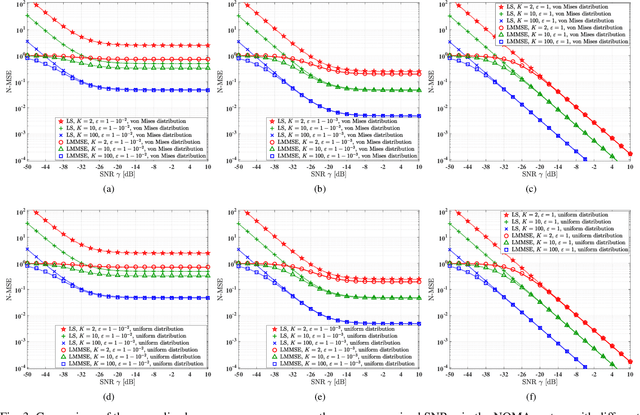
Abstract:Reconfigurable intelligent surfaces (RIS) are capable of beneficially ameliorating the propagation environment by appropriately controlling the passive reflecting elements. To extend the coverage area, the concept of simultaneous transmitting and reflecting reconfigurable intelligent surfaces (STAR-RIS) has been proposed, yielding supporting 360^circ coverage user equipment (UE) located on both sides of the RIS. In this paper, we theoretically formulate the ergodic sum-rate of the STAR-RIS assisted non-orthogonal multiple access (NOMA) uplink in the face of channel estimation errors and hardware impairments (HWI). Specifically, the STAR-RIS phase shift is configured based on the statistical channel state information (CSI), followed by linear minimum mean square error (LMMSE) channel estimation of the equivalent channel spanning from the UEs to the access point (AP). Afterwards, successive interference cancellation (SIC) is employed at the AP using the estimated instantaneous CSI, and we derive the theoretical ergodic sum-rate upper bound for both perfect and imperfect SIC decoding algorithm. The theoretical analysis and the simulation results show that both the channel estimation and the ergodic sum-rate have performance floor at high transmit power region caused by transceiver hardware impairments.
Reconfigurable Intelligent Surface Aided Amplitude- and Phase-Modulated Downlink Transmission
Jan 23, 2023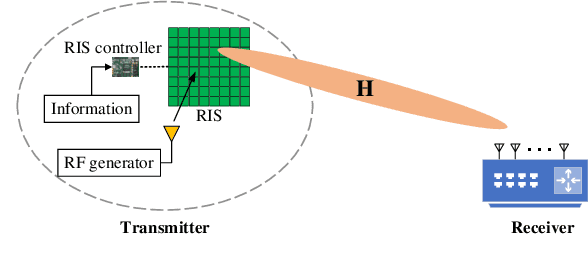
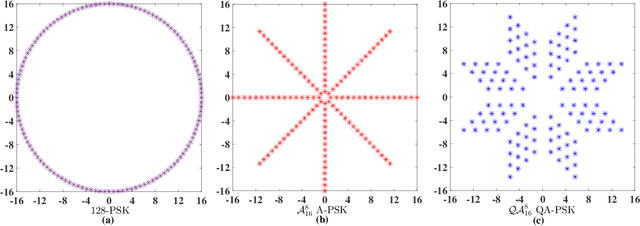
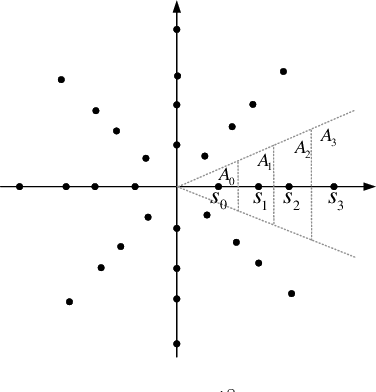
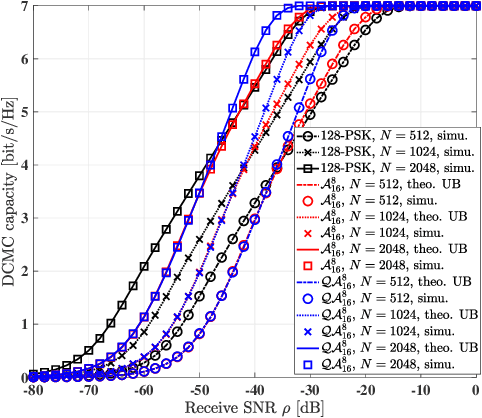
Abstract:New reconfigurable intelligent surface (RIS) based amplitude and phase modulation schemes are proposed as an evolution how the phase-only modulation schemes available in the literature. Explicitly, both the amplitude-phase shift keying (A-PSK) and quadrature amplitude-phase shift keying (QA-PSK) are conceived, where the RIS is assumed to be part of a transmitter to deliver information to the multi-antenna aided downlink receiver. In the proposed design, the RIS is partitioned into multiple blocks, and the information bits are conveyed by controlling both the ON-OFF state and the phase shift of the RIS elements in each block. Since the propagation paths spanning from each RIS block to the receiver can be coherently combined as a benefit of appropriately configuring the phase of the RIS elements, the received signal constellations can be designed by controlling both the ON-OFF pattern of the RIS blocks as well as the phase shift of the RIS elements. Both the theoretical analysis and the simulation results show that our proposed RIS-aided modulation schemes outperform the state-of-the-art RIS-based PSK modulation both in terms of its discrete-input-continuous-output memoryless channel (DCMC) capacity and its symbol error probability, especially in the high signal-to-noise-ratio (SNR) region, when considering realistic finite resolution RIS phase shifts.
Performance Analysis of Active RIS-aided Systems in the Face of Imperfect CSI and Phase Shift Noise
Jan 23, 2023



Abstract:The linear minimal mean square error (LMMSE) estimator for active reconfigurable intelligent surface (RIS)-aided wireless systems is formulated. Furthermore, based on the moment-matching method, we employ the Gamma distribution to approximate the distribution of the instantaneous received signal-to-interference-plus-noise ratio (SINR), and then derive the closed-form outage probability and ergodic channel capacity in the presence of realistic channel estimation errors, the thermal noise of RIS amplifiers and the RIS phase shift noise. Our theoretical analysis and simulation results show that the introduction of RIS amplifiers is equivalent to increasing of the transmit power, and also present the performance degradation resulting from the channel estimation error and the RIS phase noise.
Reconfigurable Intelligent Surfaces Relying on Non-Diagonal Phase Shift Matrices
Mar 15, 2022
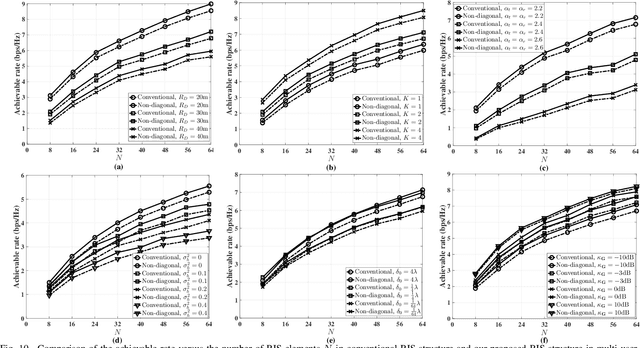


Abstract:Reconfigurable intelligent surfaces (RIS) have been actively researched as a potential technique for future wireless communications, which intelligently ameliorate the signal propagation environment. In the conventional design, each RIS element configures and reflects its received signal independently of all other RIS elements, which results in a diagonal phase shift matrix. By contrast, we propose a novel RIS architecture, where the incident signal impinging on one element can be reflected from another element after an appropriate phase shift adjustment, which increases the flexibility in the design of RIS phase shifts, hence, potentially improving the system performance. The resultant RIS phase shift matrix also has off-diagonal elements, as opposed to the pure diagonal structure of the conventional design. Compared to the state-of-art fully-connected/group-connected RIS structures, our proposed RIS architecture has lower complexity, while attaining a higher channel gain than the group-connected RIS structure, and approaching that of the fully-connected RIS structure. We formulate and solve the problem of maximizing the achievable rate of our proposed RIS architecture by jointly optimizing the transmit beamforming and the non-diagonal phase shift matrix based on alternating optimization and semi-define relaxation (SDR) methods. Moreover, the closed-form expressions of the channel gain, the outage probability and bit error ratio (BER) are derived. Simulation results demonstrate that our proposed RIS architecture results in an improved performance in terms of the achievable rate compared to the conventional architecture, both in single-user as well as in multi-user scenarios.
 Add to Chrome
Add to Chrome Add to Firefox
Add to Firefox Add to Edge
Add to Edge